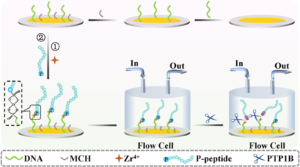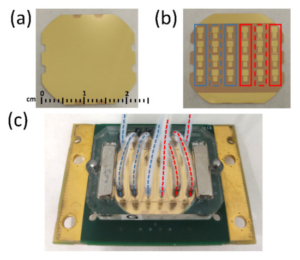First Direct Gravimetric Detection of Perfluorooctane Sulfonic Acid (PFOS) Water Contaminants, Combination with Electrical Measurements on the Same Device—Proof of Concepts
Authors: Ivanov, G.R.; Venelinov, T.; Marinov, Y.G.; Hadjichristov, G.B.; Terfort, A.; David, M.; Florescu, M.; Karakuş, S.
Journal: Chemosensors
Abstract:
Perfluoroalkyl and polyfluoroalkyl substances (PFAS) are pollutants of concern due to their long-term persistence in the environment and human health effects. Among them, perfluorooctane sulfonic acid (PFOS) is very ubiquitous and dangerous for health. Currently, the detection levels required by the legislation can be achieved only with expensive laboratory equipment. Hence, there is a need for portable, in-field, and possibly real-time detection. Optical and electrochemical transduction mechanisms are mainly used for the chemical sensors. Here, we report the first gravimetric detection of small-sized molecules like PFOS (MW 500) dissolved in water. A 100 MHz quartz crystal microbalance (QCM) measured at the third harmonic and an even more sensitive 434 MHz two-port surface acoustic wave (SAW) resonator with gold electrodes were used as transducers. The PFOS selective sensing layer was prepared from the metal organic framework (MOF) MIL-101(Cr). Its nano-sized thickness and structure were optimized using the discreet Langmuir–Blodgett (LB) film deposition method. This is the first time that LB multilayers from bulk MOFs have been prepared. The measured frequency downshifts of around 220 kHz per 1 µmol/L of PFOS, a SAW resonator-loaded QL-factor above 2000, and reaction times in the minutes’ range are highly promising for an in-field sensor reaching the water safety directives. Additionally, we use the micrometer-sized interdigitated electrodes of the SAW resonator to strongly enhance the electrochemical impedance spectroscopy (EIS) of the PFOS contamination. Thus, for the first time, we combine the ultra-sensitive gravimetry of small molecules in a water environment with electrical measurements on a single device. This combination provides additional sensor selectivity. Control tests against a bare resonator and two similar compounds prove the concept’s viability. All measurements were performed with pocket-sized tablet-powered devices, thus making the system highly portable and field-deployable. While here we focus on one of the emerging water contaminants, this concept with a different selective coating can be used for other new contaminants.


 The abnormal expression of protein tyrosine phosphatase 1B (PTP1B) is highly related to several serious human diseases. Therefore, an accurate PTP1B activity assay is beneficial to the diagnosis and treatment of these diseases. In this study, a dual-mode biosensing platform that enabled the sensitive and accurate assay of PTP1B activity was constructed based on the high-frequency (100 MHz) quartz crystal microbalance (QCM) and dual-signaling electrochemical (EC) ratiometric strategy. Covalent–organic framework@gold nanoparticles@ferrocene@single-strand DNA (COF@Au@Fc-S0) was introduced onto the QCM Au chip via the chelation between Zr4+ and phosphate groups (phosphate group of the phosphopeptide (P-peptide) on the QCM Au chip and the phosphate group of thiol-labeled single-stranded DNA (S0) on COF@Au@Fc-S0) and used as a signal reporter. When PTP1B was present, the dephosphorylation of the P-peptide led to the release of COF@Au@Fc-S0 from the QCM Au chip, resulting in an increase in the frequency of the QCM. Meanwhile, the released COF@Au@Fc-S0 hybridized with thiol/methylene blue (MB)-labeled hairpin DNA (S1-MB) on the Au NPs-modified indium–tin oxide (ITO) electrode. This caused MB to be far away from the electrode surface and Fc to be close to the electrode, leading to a decrease in the oxidation peak current of MB and an increase in the oxidation peak current of Fc. Thus, PTP1B-induced dephosphorylation of the P-peptide was monitored in real time by QCM, and PTP1B activity was detected sensitively and reliably using this innovative QCM-EC dual-mode sensing platform with an ultralow detection limit. This platform is anticipated to serve as a robust tool for the analysis of protein phosphatase activity and the discovery of drugs targeting protein phosphatase.
The abnormal expression of protein tyrosine phosphatase 1B (PTP1B) is highly related to several serious human diseases. Therefore, an accurate PTP1B activity assay is beneficial to the diagnosis and treatment of these diseases. In this study, a dual-mode biosensing platform that enabled the sensitive and accurate assay of PTP1B activity was constructed based on the high-frequency (100 MHz) quartz crystal microbalance (QCM) and dual-signaling electrochemical (EC) ratiometric strategy. Covalent–organic framework@gold nanoparticles@ferrocene@single-strand DNA (COF@Au@Fc-S0) was introduced onto the QCM Au chip via the chelation between Zr4+ and phosphate groups (phosphate group of the phosphopeptide (P-peptide) on the QCM Au chip and the phosphate group of thiol-labeled single-stranded DNA (S0) on COF@Au@Fc-S0) and used as a signal reporter. When PTP1B was present, the dephosphorylation of the P-peptide led to the release of COF@Au@Fc-S0 from the QCM Au chip, resulting in an increase in the frequency of the QCM. Meanwhile, the released COF@Au@Fc-S0 hybridized with thiol/methylene blue (MB)-labeled hairpin DNA (S1-MB) on the Au NPs-modified indium–tin oxide (ITO) electrode. This caused MB to be far away from the electrode surface and Fc to be close to the electrode, leading to a decrease in the oxidation peak current of MB and an increase in the oxidation peak current of Fc. Thus, PTP1B-induced dephosphorylation of the P-peptide was monitored in real time by QCM, and PTP1B activity was detected sensitively and reliably using this innovative QCM-EC dual-mode sensing platform with an ultralow detection limit. This platform is anticipated to serve as a robust tool for the analysis of protein phosphatase activity and the discovery of drugs targeting protein phosphatase. The misregulation of protein phosphatases is a key factor in the development of many human diseases, notably cancers. Here, based on a 100 MHz quartz crystal microbalance (QCM) biosensing platform, the dephosphorylation process of phosphopeptide (P-peptide) caused by protein tyrosine phosphatase 1B (PTP1B) was monitored in real time for the first time and PTP1B activity was assayed rapidly and sensitively. The QCM chip, coated with a gold (Au) film, was used to immobilized thiol-labeled single-stranded 5′-phosphate-DNAs (P-DNA) through Au–S bond. The P-peptide, specific to PTP1B, was then connected to the P-DNA via chelation between Zr4+ and phosphate groups. When PTP1B was injected into the QCM flow cell where the P-peptide/Zr4+/MCH/P-DNA/Au chip was placed, the P-peptide was dephosphorylated and released from the Au chip surface, resulting in an increase in the frequency of the QCM Au chip. This allowed the real-time monitoring of the P-peptide dephosphorylation process and sensitive detection of PTP1B activity within 6 min with a linear detection range of 0.01–100 pM and a detection limit of 0.008 pM. In addition, the maximum inhibitory ratios of inhibitors were evaluated using this proposed 100 MHz QCM biosensor. The developed 100 MHz QCM biosensing platform shows immense potential for early diagnosis of diseases related to protein phosphatases and the development of drugs targeting protein phosphatases.
The misregulation of protein phosphatases is a key factor in the development of many human diseases, notably cancers. Here, based on a 100 MHz quartz crystal microbalance (QCM) biosensing platform, the dephosphorylation process of phosphopeptide (P-peptide) caused by protein tyrosine phosphatase 1B (PTP1B) was monitored in real time for the first time and PTP1B activity was assayed rapidly and sensitively. The QCM chip, coated with a gold (Au) film, was used to immobilized thiol-labeled single-stranded 5′-phosphate-DNAs (P-DNA) through Au–S bond. The P-peptide, specific to PTP1B, was then connected to the P-DNA via chelation between Zr4+ and phosphate groups. When PTP1B was injected into the QCM flow cell where the P-peptide/Zr4+/MCH/P-DNA/Au chip was placed, the P-peptide was dephosphorylated and released from the Au chip surface, resulting in an increase in the frequency of the QCM Au chip. This allowed the real-time monitoring of the P-peptide dephosphorylation process and sensitive detection of PTP1B activity within 6 min with a linear detection range of 0.01–100 pM and a detection limit of 0.008 pM. In addition, the maximum inhibitory ratios of inhibitors were evaluated using this proposed 100 MHz QCM biosensor. The developed 100 MHz QCM biosensing platform shows immense potential for early diagnosis of diseases related to protein phosphatases and the development of drugs targeting protein phosphatases.

